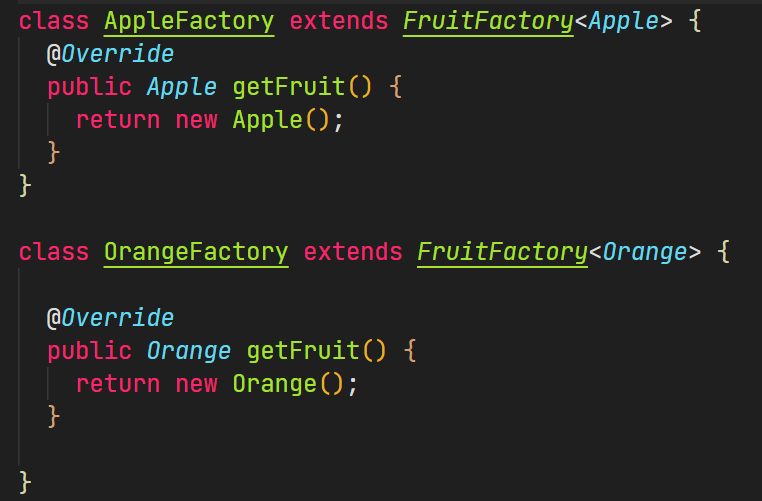工厂方法模式
默认情况下,我们都是直接使用new的方式去创建对象,但是当我们的程序中大量使用这种方式进行创建对象时,如果这个类的构造方法发生了改变,那就要挨个去进行修改。
因此我们可以直接通过工厂来创建对象,这样如果后续要进行修改,只需要修改工厂类中的实现细节即可。
public class App {public static void main(String[] args) {Fruit fruit = FruitFactory.getFruit("apple");System.out.println(fruit);}}class Fruit {private String name;public Fruit(String name) {this.name = name;}@Overridepublic String toString() {return "Fruit [name=" + name + "]";}}class Apple extends Fruit {public Apple() {super("苹果");}}class Orange extends Fruit {public Orange() {super("橘子");}}class FruitFactory {public static Fruit getFruit(String fruitName) {switch (fruitName) {case "apple":return new Apple();case "orange":return new Orange();default:return null;}}}
这样,根据给工厂类传入的参数不同,就可以创建、获取不同类的对象。
但上述方式也存在一些问题
如果现在要先加一种类型的水果,那么除了要创建一个新的类以外,还要修改工厂类中的代码,这显然是违背了开闭原则的
因此我们将代码修改为如下:
创建一个抽象工厂类,来定义一种规则,并使用泛型来约束入参

具体的工厂类只需要继承这个抽象类,并定义自身的行为即可

整体代码如下
package code2;class Fruit {private String name;public Fruit(String name) {this.name = name;}@Overridepublic String toString() {return "Fruit [name=" + name + "]";}}class Apple extends Fruit {public Apple() {super("苹果");}}class Orange extends Fruit {public Orange() {super("橘子");}}abstract class FruitFactory<T extends Fruit> {public abstract T getFruit();}class AppleFactory extends FruitFactory<Apple> {@Overridepublic Apple getFruit() {return new Apple();}}class OrangeFactory extends FruitFactory<Orange> {@Overridepublic Orange getFruit() {return new Orange();}}public class App {public static void main(String[] args) {// 通过AppleFactory获取Apple对象Apple apple = new AppleFactory().getFruit();System.out.println(apple);}}
抽象工厂模式
建造者模式
如果某个类中的字段数目太多,那么在手动new创建对象的时候,就会导致需要传递太多参数。
package code3;public class App2 {public static void main(String[] args) {Student student = new Student(1, "yxr", 19, "三峡大学");System.out.println(student);}}// 省略了构造函数等方法class Student {private Integer id;private String name;private Integer age;private String college;}
为了避免传递过多的参数,并且让方法支持链式调用,我们可以使用建造者模式,通过builder来创建对象

